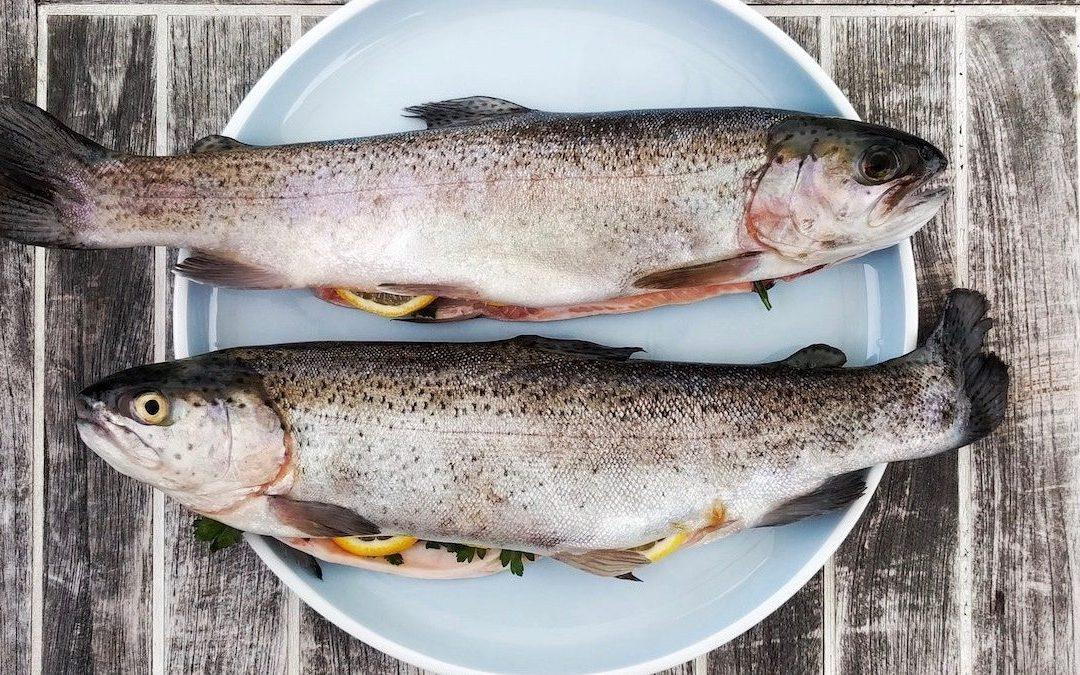
- posted: Sep. 04, 2019
Fish – that beautiful, edible gift from the sea. It’s an excellent health booster and the cornerstone of many a tasty meal. But, as the saying goes, you are what you eat, so eating the healthiest and most responsibly sourced fish possible is essential to extract maximum benefits. But eating fish is a tricky business — there are the issues of over-fishing, ecological impact and mercury levels to factor onto your plate as well.
So, how to navigate the wild world of fish in a way that supports both your body and the ocean? Start by learning more about the fish you buy, know what to avoid – and don’t be fooled by confusing labeling or tempting super-sale prices! Here’s where to start:
First things first: red-line factory farmed fish.
Rising worldwide demand for fish, a healthy source of omega-3s and protein, has in the last few decades grown so rapidly, it’s spawned what’s become the multi-billion dollar fish farming industry, also known as aquaculture. Though the idea of producing, or farming, fish on a massive scale may seem to be an appropriate response to meet the enormous demand, in practice, large-scale fish ‘production’ brings with it many of the same type of problems that factory farmed meats do.
Just like industrial animal farms, fish farms produce millions of creatures, stressed-out and made sick by living in filthy, over-crowded conditions. They’re fed cheap GMO fishmeal pellets, bathed in pesticides and shot full of antibiotics and hormones to speed growth. The result is a cheap, nutritionally bankrupt (and in some cases, even radioactive) product – with a higher percentage of inflammatory omega-6 fatty acids (!) – that winds up polluting not only your body but also the bodies of water from whence it came. So, nobody benefits – except the producers.
While there are a few small, artisanal-style aquaculture fish farm operations that are raising fish the right way – keep in mind they are the exception, so you’ll need to do some research to source them and be prepared to pay a premium for all that extra care.
For an inside look at how the farmed fishing industry works, and the dangers of farmed fish, take a look at this in-depth, eye-opening documentary ‘Farmed Norwegian Salmon: World’s Most Toxic Food’
Be conscious of mercury.
When it comes to fish, too much of a good thing can cause trouble, namely in the form of your mercury levels. Too often, fish can be contaminated with unacceptable amounts of dioxins and neurotoxic mercury emitted by industrial sources that pollute habitats and ultimately the fish. As it moves up the aquatic food chain, the mercury accumulates, which is why eating small fish like sardines and anchovies is much safer than eating larger fish like tuna and swordfish, which can grow 800 pounds or more, accumulating more and more mercury as they mature.
Go a little wild and school yourself.
Though the overwhelming majority of farmed fish does your health no favors, the better-for-you wild fish have their pros and cons too – so it’s a bit of a balancing act. On the plus side, wild fish tends to contain far fewer contaminants than factory farmed while also delivering more protein and more omega 3 fatty acids. But over-fishing is a serious threat to many species, so you must try to select your fish species with care. Not a marine biologist? Well, neither are we, so we rely on the marine brainiacs at the Monterey Bay Aquarium’s site to guide us. We love their website, Seafoodwatch.org, which provides recommendations on the best fish options, good alternatives, and the must-avoids for more than 50 of the most common species of fish that you’re likely come across at your local market. The Blue Ocean Institute’s Guide to Ocean Friendly Seafood is another excellent resource to help you buy your fish wisely.
Navigate the restaurant menu waters too.
Eat out frequently? Then you’ll appreciate the on-the-go convenience of the SeafoodWatch app to guide you to the best choices at the restaurant (and at the market, too). You can also checkout FishChoice.com, which verifies that the fish served at participating restaurants is sourced from sustainable fisheries.
Another tip: When dining out, put the phone down and don’t be afraid to ask your server pointed questions about the provenance of their fish, particularly where it’s from and if it’s farmed or not – then cross check the details with your app. If your server doesn’t have the answers, or you think they might be fudging the truth a bit, consider ordering a different entrée!
More of a paper person? Then print out a copy of The Environmental Defense Fund’s handy guide called the “Seafood Selector” which rates the typical mercury levels in hundreds of fish species, ranks their ecological impact, and offers recommendations on how often (or not) to eat a particular species. Tuck it in your wallet so you have it the next time you’re shopping for fish.
Know what what’s going on in your tuna sandwich.
If, despite the mercury issue, you’re still a staunch tuna-for-lunch fan, eat it sparingly, and smartly. Cut back to once a week at most – and make sure your tuna is ‘pole and line caught,’ meaning the tuna are caught one at a time, versus the far more destructive ‘gillnet’ fishing which scoops up and often kills just about every marine creature it drags up.
Opt for BPA-free, canned light tuna, which tends to be much lower in mercury than chunk white, and preferably skipjack, which is a much smaller fish, carrying less mercury than albacore, up to three times less by some counts.
For a deeper dive on tuna, take a look at Greenpeace’s handy canned tuna guide canned tuna guide, which ranks 20 well-known, grocery store canned tuna brands based on how sustainable, ethical, and fair their tuna products are for our oceans—and for the workers that help get the products to store shelves.
Better yet – ditch the tuna and switch to canned wild salmon from Alaska which is richer in omega-3s and vitamin D and has a lower mercury risk than tuna.
Tip: if you don’t have access to good seafood options at your local market or seafood restaurant, order online from a company like Vital Choice, and cook at home!
